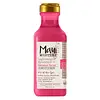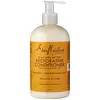What's inside
What's inside
 Key Ingredients
Key Ingredients

 Benefits
Benefits

 Concerns
Concerns

 Ingredients Side-by-side
Ingredients Side-by-side

Aloe Barbadensis Leaf
MaskingWater
Skin ConditioningBehentrimonium Chloride
PreservativeCetearyl Alcohol
EmollientCetyl Alcohol
EmollientGlycerin
HumectantPPG-3 Benzyl Ether Myristate
EmollientSteareth-20
CleansingCocos Nucifera Water
MaskingHibiscus Abelmoschus Flower/Seed Water
MaskingPassiflora Incarnata Fruit Extract
Skin ConditioningCitrus Medica Vulgaris Fruit Extract
AntioxidantUndecane
EmollientPolyquaternium-47
Skin ConditioningTridecane
PerfumingPolyquaternium-37
Glycol Distearate
EmollientPropylene Glycol Dicaprylate/Dicaprate
EmollientPPG-1 Trideceth-6
Skin ConditioningIsopropyl Alcohol
SolventMaltodextrin
AbsorbentCitric Acid
BufferingSodium Hydroxide
BufferingSodium Benzoate
MaskingParfum
MaskingAloe Barbadensis Leaf, Water, Behentrimonium Chloride, Cetearyl Alcohol, Cetyl Alcohol, Glycerin, PPG-3 Benzyl Ether Myristate, Steareth-20, Cocos Nucifera Water, Hibiscus Abelmoschus Flower/Seed Water, Passiflora Incarnata Fruit Extract, Citrus Medica Vulgaris Fruit Extract, Undecane, Polyquaternium-47, Tridecane, Polyquaternium-37, Glycol Distearate, Propylene Glycol Dicaprylate/Dicaprate, PPG-1 Trideceth-6, Isopropyl Alcohol, Maltodextrin, Citric Acid, Sodium Hydroxide, Sodium Benzoate, Parfum
Water
Skin ConditioningStearyl Alcohol
EmollientOlea Europaea Fruit Oil
MaskingBehentrimonium Chloride
PreservativeCetyl Alcohol
EmollientButyrospermum Parkii Butter
Skin ConditioningGlyceryl Caprylate
EmollientArgania Spinosa Kernel Oil
EmollientMacrocystis Pyrifera Extract
Skin ConditioningSimmondsia Chinensis Seed Oil
EmollientDaucus Carota Sativa Seed Oil
EmollientHydrolyzed Silk
HumectantHydrolyzed Soy Protein
HumectantAloe Barbadensis Leaf Juice
Skin ConditioningPanthenol
Skin ConditioningTocopheryl Acetate
AntioxidantDicaprylyl Ether
EmollientSodium Isostearoyl Lactylate
EmulsifyingSodium Benzoate
MaskingHydroxyethylcellulose
Emulsion StabilisingGlyceryl Undecylenate
EmollientParfum
MaskingWater, Stearyl Alcohol, Olea Europaea Fruit Oil, Behentrimonium Chloride, Cetyl Alcohol, Butyrospermum Parkii Butter, Glyceryl Caprylate, Argania Spinosa Kernel Oil, Macrocystis Pyrifera Extract, Simmondsia Chinensis Seed Oil, Daucus Carota Sativa Seed Oil, Hydrolyzed Silk, Hydrolyzed Soy Protein, Aloe Barbadensis Leaf Juice, Panthenol, Tocopheryl Acetate, Dicaprylyl Ether, Sodium Isostearoyl Lactylate, Sodium Benzoate, Hydroxyethylcellulose, Glyceryl Undecylenate, Parfum
Ingredients Explained
These ingredients are found in both products.
Ingredients higher up in an ingredient list are typically present in a larger amount.
This ingredient is a preservative and often used for it's anti-static properties. You'll most likely see this ingredient in hair conditioners.
It does not cause irritation or sensitization in leave-on products at 1-5%.
Cetyl Alcohol is a fatty alcohol. Fatty Alcohols are most often used as an emollient or to thicken a product.
Its main roles are:
Though it has "alcohol" in the name, it is not related to denatured alcohol or ethyl alcohol.
The FDA allows products labeled "alcohol-free" to have fatty alcohols.
Learn more about Cetyl AlcoholParfum is a catch-all term for an ingredient or more that is used to give a scent to products.
Also called "fragrance", this ingredient can be a blend of hundreds of chemicals or plant oils. This means every product with "fragrance" or "parfum" in the ingredients list is a different mixture.
For instance, Habanolide is a proprietary trade name for a specific aroma chemical. When used as a fragrance ingredient in cosmetics, most aroma chemicals fall under the broad labeling category of “FRAGRANCE” or “PARFUM” according to EU and US regulations.
The term 'parfum' or 'fragrance' is not regulated in many countries. In many cases, it is up to the brand to define this term.
For instance, many brands choose to label themselves as "fragrance-free" because they are not using synthetic fragrances. However, their products may still contain ingredients such as essential oils that are considered a fragrance by INCI standards.
One example is Calendula flower extract. Calendula is an essential oil that still imparts a scent or 'fragrance'.
Depending on the blend, the ingredients in the mixture can cause allergies and sensitivities on the skin. Some ingredients that are known EU allergens include linalool and citronellol.
Parfum can also be used to mask or cover an unpleasant scent.
The bottom line is: not all fragrances/parfum/ingredients are created equally. If you are worried about fragrances, we recommend taking a closer look at an ingredient. And of course, we always recommend speaking with a professional.
Learn more about ParfumSodium Benzoate is a preservative. It's used in both cosmetic and food products to inhibit the growth of mold and bacteria. It is typically produced synthetically.
Both the US FDA and EU Health Committee have approved the use of sodium benzoate. In the US, levels of 0.1% (of the total product) are allowed.
Sodium benzoate works as a preservative by inhibiting the growth of bacteria inside of cells. It prevents the cell from fermenting a type of sugar using an enzyme called phosphofructokinase.
It is the salt of benzoic acid. Foods containing sodium benzoate include soda, salad dressings, condiments, fruit juices, wines, and snack foods.
Studies for using ascorbic acid and sodium benzoate in cosmetics are lacking, especially in skincare routines with multiple steps.
We always recommend speaking with a professional, such as a dermatologist, if you have any concerns.
Learn more about Sodium BenzoateWater. It's the most common cosmetic ingredient of all. You'll usually see it at the top of ingredient lists, meaning that it makes up the largest part of the product.
So why is it so popular? Water most often acts as a solvent - this means that it helps dissolve other ingredients into the formulation.
You'll also recognize water as that liquid we all need to stay alive. If you see this, drink a glass of water. Stay hydrated!
Learn more about Water